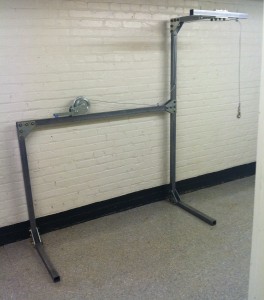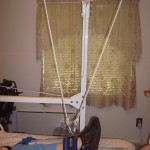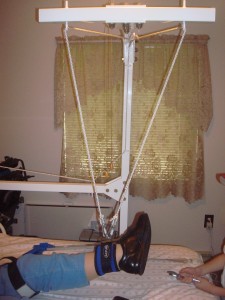Designers: Matthew Davis, Rebecca Mann, Kenneth Addison
Client Coordinators: Katie Stephens, PT
INTRODUCTION
Our client, Joyce, is a middle-aged woman with Multiple Sclerosis, which is a chronic disease that attacks the central nervous system and results in decreased muscle strength. Joyce has significant weakness in her legs, such that she cannot move either leg independently while seated or supine because she cannot overcome the friction force between her leg and the resting surface. To address this issue, her physical therapist has been working with Joyce to increase leg strength. At the clinic, Joyce lays supine on the table, and the therapist lifts her leg above the table by attaching straps around Joyce’s thigh and ankle, and connecting the other end of the straps to a hook in the ceiling. With Joyce’s leg suspended above the table, she can freely move it from side to side to develop better strength. She repeats these exercises with both legs. Since she began these exercises, she has already noticed an increase in her lower body strength, and she wants to be able to do these exercises at home on a daily basis. Therefore, Joyce needs a means to raise her legs over the surface of her bed, one at a time. However, she needs to be able to do this independently, as she lives alone, and she cannot attach anything to the ceiling, as there is a ceiling fan above her bed.
We developed a device that attaches to Joyce’s bed and lifts her leg over the surface so that she can conduct a variety of leg exercises independently. With her leg suspended above the bed, she can lie supine and swing a leg from side to side. She can also lie on her side and perform an exercise that targets her hamstrings and quadriceps. The device has connection points for additional straps, which will enable her to conduct more strenuous exercises in the future.

Figure 1: Photo of the One Leg Up Device before it was powder coated in white and attached to her bed. The left side of the frame is toward the head of the bed, where the client can reach the winch, and the clients legs are attached to the part of the frame that cantilevers over the bed. The legs at the bottom of the frame will attach to the bed.
SUMMARY OF IMPACT
After the first test run with a prototype, Joyce said “I am excited about having this [device] because it will allow me to move my legs, to exercise them, and make them stronger, and that’s what the goal is right now.” On the day of the final delivery, the physical therapist said, “you guys put together a great device and I think it will be very useful for Joyce to practice her home exercise program independently. She may need a little help at first but eventually it should be a great tool for her to continue to get stronger.”
TECHNICAL DESCRIPTION
Our device consists of a steel frame that attaches to the base of the client’s bed. This acts as a support system for two ropes that hang over the center of the bed. The client places a velcro strap around her thigh and another strap around her ankle and connects the straps to the overhanging ropes using carabiners. Once connected, she uses a winch to crank her leg up to a comfortable height, typically 6-12 inches above the bed. After she completes each exercise, she can reverse the direction of the winch and lower her leg in a steady and controlled manner. She can repeat this process on the other leg.
The frame of the device is made from of 2”x2” rectangular steel tubing. The base of the frame slides into matching 2”x2” slits that are cut into the wood blocks fit under the legs of her bed. This was done to allow the weight of the bed to counteract the torque created by the movement of her leg. Because the frame was only slid under the posts of one side of the bed, we also added blocks of the same height to the other side of the bed to make it level, while still at an appropriate height for the client to transfer from her wheelchair. The frame of our device supports the winch and the rope. It runs along the side of the bed and cantilevers over the middle of the bed so that the client’s leg can be raised above the bed.
The hand winch was selected to allow the client to have manual control when raising and lowering her leg. To accomplish this, a 1,000 pound capacity Haul-Master® winch with bi-directional control was selected. The client is able to raise her leg by turning the handle, and then press a simple switch to reverse the ratchet direction. Then, she can rotate the handle in the opposite direction in order to lower her leg one gear tooth at a time. This feature is necessary to ensure that the client would be able to control the speed at which her leg was lowered.
The winch is wound with 30’ of dock line rope, rated at 240 pounds. The rope is guided along the tube using eyelets. After the rope reaches the cantilever, it is tied off into a loop and a second piece of rope is run through this loop, with carabiners attached to each end. This design allows the client to connect the rope to both her thigh and ankle at the same time. The crank could then be turned to raise her leg or lower it, giving her full leg placement control.
The total cost of this device is $400.



University Operator: (919) 962-2211 | © 2024 The University of North Carolina at Chapel Hill |